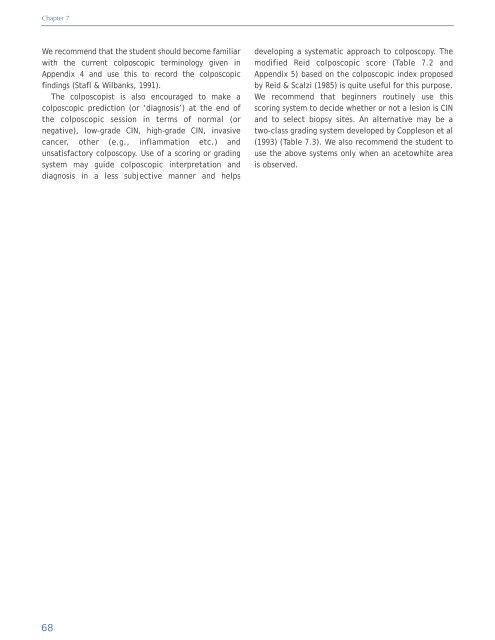Colposcopy and Treatment of Cervical Intraepithelial Neoplasia - RHO
Colposcopy and Treatment of Cervical Intraepithelial Neoplasia - RHO
Colposcopy and Treatment of Cervical Intraepithelial Neoplasia - RHO
Create successful ePaper yourself
Turn your PDF publications into a flip-book with our unique Google optimized e-Paper software.
Chapter 7<br />
We recommend that the student should become familiar<br />
with the current colposcopic terminology given in<br />
Appendix 4 <strong>and</strong> use this to record the colposcopic<br />
findings (Stafl & Wilbanks, 1991).<br />
The colposcopist is also encouraged to make a<br />
colposcopic prediction (or ‘diagnosis’) at the end <strong>of</strong><br />
the colposcopic session in terms <strong>of</strong> normal (or<br />
negative), low-grade CIN, high-grade CIN, invasive<br />
cancer, other (e.g., inflammation etc.) <strong>and</strong><br />
unsatisfactory colposcopy. Use <strong>of</strong> a scoring or grading<br />
system may guide colposcopic interpretation <strong>and</strong><br />
diagnosis in a less subjective manner <strong>and</strong> helps<br />
developing a systematic approach to colposcopy. The<br />
modified Reid colposcopic score (Table 7.2 <strong>and</strong><br />
Appendix 5) based on the colposcopic index proposed<br />
by Reid & Scalzi (1985) is quite useful for this purpose.<br />
We recommend that beginners routinely use this<br />
scoring system to decide whether or not a lesion is CIN<br />
<strong>and</strong> to select biopsy sites. An alternative may be a<br />
two-class grading system developed by Coppleson et al<br />
(1993) (Table 7.3). We also recommend the student to<br />
use the above systems only when an acetowhite area<br />
is observed.<br />
68
















